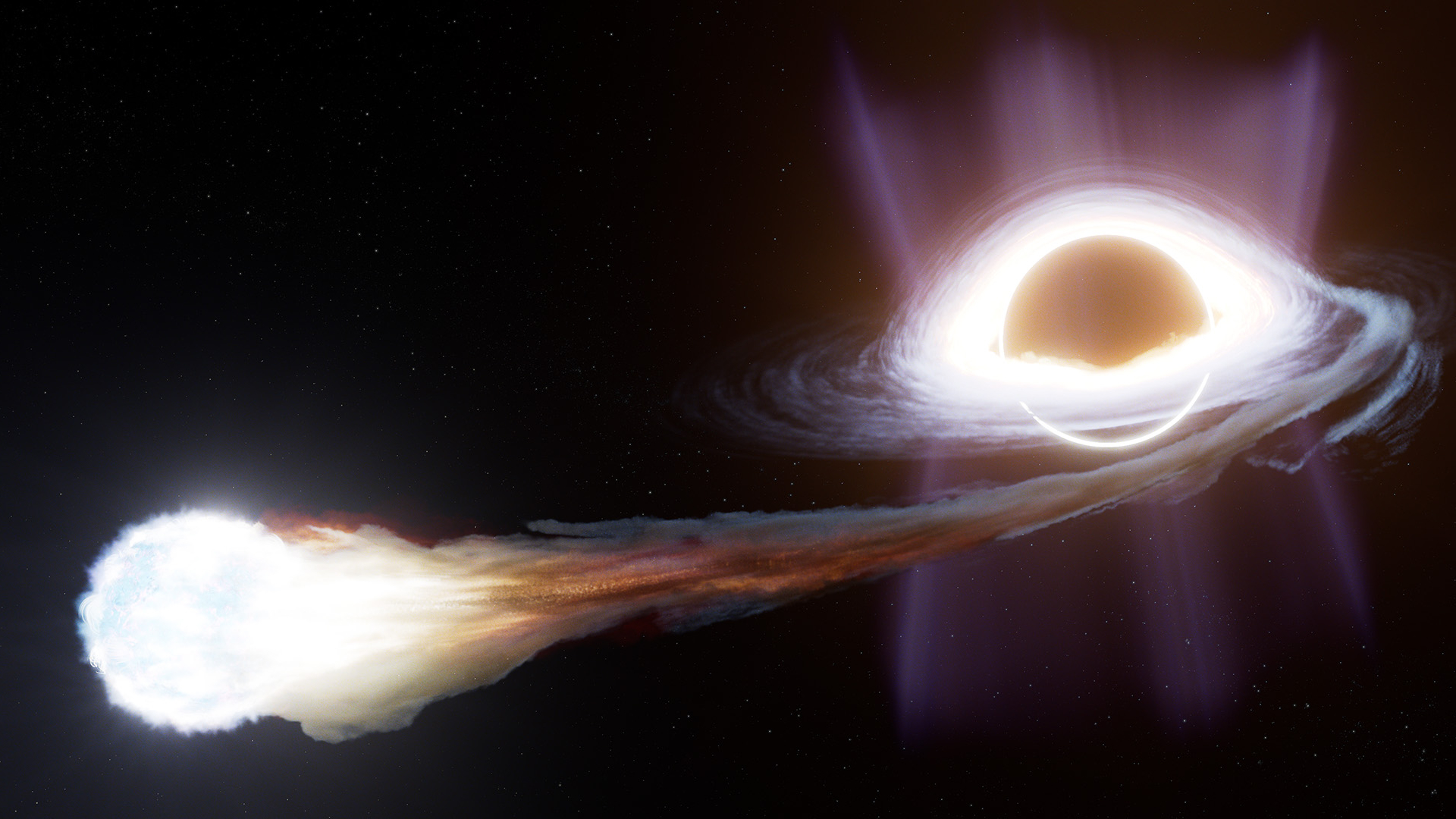Rule-breaking black hole destroys star in puzzling way: 'This is truly extraordinary'
The black hole could have been a member of the elusive intermediate mass black holes.

The death of a star at the hands of a massive black hole in a galaxy 650 million light-years away has surprised astronomers, for not only taking place outside the center of the galaxy, where massive black holes usually lurk, but also for launching two high-energy outflows months after the star's destruction.
When a star becomes caught in the vice-like gravitational grip of a massive black hole, tidal forces set about stretching and tearing the star apart. Such events, referred to as "tidal disruption events," or TDEs, are relatively common. They liberate a huge amount of energy as the star is ripped apart and its remains form a disk of debris around the black hole.
In this case, the optical flare of the TDE was spotted in 2024 by the Zwicky Transient Facility on the 48-inch Samuel Oschin Telescope at Palomar Observatory in California. Constant monitoring of the TDE, designated AT 2024tvd, at radio wavelengths over the next 10 months by an array of telescopes identified two distinct radio flares — for some reason, delayed by 80 and 194 days after the onset of the TDE respectively.
Even more surprising, however, was the location of the TDE: about 2,600 light years from the center of its host galaxy. Most TDEs take place in the center of a galaxy, where a supermassive black hole lurks.
Only three have ever been seen off-center.
"This is truly extraordinary," Itai Sfaradi of the University of California, Berkeley, said in a statement. "Never before have we seen such bright radio emission from a black hole tearing apart a star, away from a galaxy's center, and evolving this fast. It changes how we think about black holes and their behavior."
Sfaradi and his Berkeley colleague, Raffaella Margutti, led an international team to track the development of the TDE using the Very Large Array in New Mexico, the Allen Telescope Array in California and the Submillimeter Array in Hawaii, as well as the Atacama Large Millimeter/submillimetre Array (ALMA) in Chile and the Arcminute Microkelvin Imager Large Array (AMI-LA) at Cambridge University’s Mullard Radio Astronomy Observatory.
Breaking space news, the latest updates on rocket launches, skywatching events and more!
It was AMI-LA that was key to capturing the surprisingly fast development of the radio emission — fast in the sense that its energy rose and changed quickly. These radio waves are produced when an outflow of material slams into gas that surrounds the black hole. This gas could be the ordinary interstellar medium, or debris from the destroyed star.
Why these outflows were so delayed following the TDE remains a mystery. The first radio flare also came with a detected X-ray component, leading Sfaradi’s team to suspect that this outflow was accretion-driven: in other words, some of the debris in the accretion disk flowing onto the black hole was spat back out by the black hole's magnetic fields.
The second flare is even more puzzling.
Either it was a jet of material moving at half the speed of light that was launched 170 days after the TDE and took 24 days to reach the surrounding gas, or a jet moving at almost the speed of light that was launched after 190 days. What connection this second outburst has with the first, and whether it was produced by the accretion of the same material, remains unclear.
As for the black hole, Sfaradi's best guess is that it is an intermediate mass black hole — that is, a black hole with a mass between 1,000 and 100,000 times the mass of our sun. It could have found itself outside of the galaxy's center in one of two ways. Either it was a participant in a triple black hole interaction at the center of its galaxy that saw it thrown out, or it was once the central black hole of a smaller galaxy that collided and merged with a larger one, and the black hole is now wandering like a violent rogue through its new galaxy, obliterating any unfortunate stars that get in its way.
The results were published on Oct. 13 in The Astrophysical Journal Letters.

Keith Cooper is a freelance science journalist and editor in the United Kingdom, and has a degree in physics and astrophysics from the University of Manchester. He's the author of "The Contact Paradox: Challenging Our Assumptions in the Search for Extraterrestrial Intelligence" (Bloomsbury Sigma, 2020) and has written articles on astronomy, space, physics and astrobiology for a multitude of magazines and websites.
You must confirm your public display name before commenting
Please logout and then login again, you will then be prompted to enter your display name.
